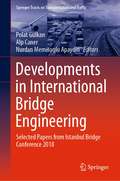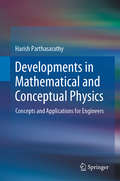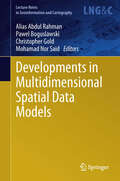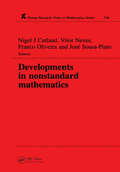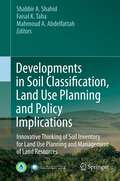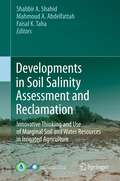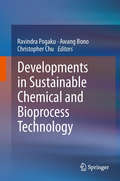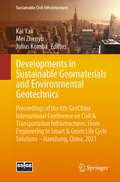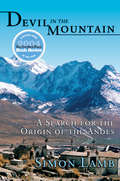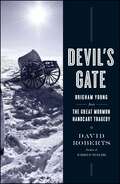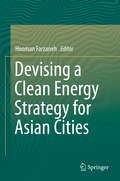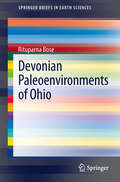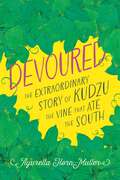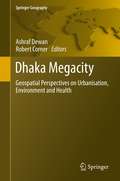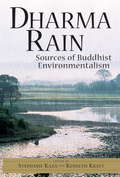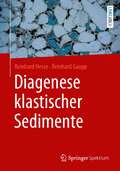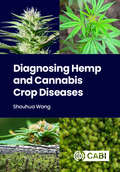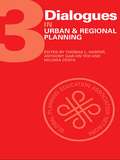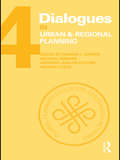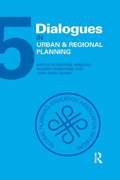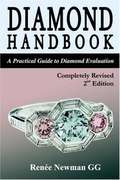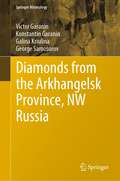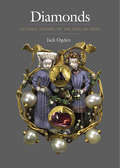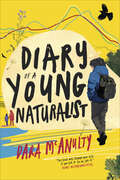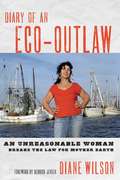- Table View
- List View
Developments in International Bridge Engineering: Selected Papers from Istanbul Bridge Conference 2018 (Springer Tracts on Transportation and Traffic #17)
by Alp Caner Polat Gülkan Nurdan Memisoglu ApaydinThis book reports on current challenges in bridge engineering faced by professionals around the globe, giving a special emphasis to recently developed techniques and methods for bridge design, construction and monitoring. Based on extended and revised papers selected from outstanding presentation at the Istanbul Bridge Conference 2018, held from November 5 – 6, 2018, in Istanbul, Turkey, and by highlighting major bridge studies, spanning from numerical and modeling studies to the applications of new construction techniques and monitoring systems, this book is intended to promote high standards in modern bridge engineering. It offers a timely reference to both academics and professionals in this field.
Developments in Mathematical and Conceptual Physics: Concepts and Applications for Engineers
by Harish ParthasarathyThis book presents concepts of theoretical physics with engineering applications. The topics are of an intense mathematical nature involving tools like probability and random processes, ordinary and partial differential equations, linear algebra and infinite-dimensional operator theory, perturbation theory, stochastic differential equations, and Riemannian geometry. These mathematical tools have been applied to study problems in mechanics, fluid dynamics, quantum mechanics and quantum field theory, nonlinear dynamical systems, general relativity, cosmology, and electrodynamics. A particularly interesting topic of research interest developed in this book is the design of quantum unitary gates of large size using the Feynman diagrammatic approach to quantum field theory. Through this book, the reader will be able to observe how basic physics can revolutionize technology and also how diverse branches of mathematical physics like large deviation theory, quantum field theory, general relativity, and electrodynamics have many common issues that provide the starting point for unifying the whole of physics, namely in the formulation of Grand Unified Theories (GUTS).
Developments in Multidimensional Spatial Data Models
by Alias Abdul Rahman Christopher Gold Mohamad Nor Said Pawel BoguslawskiThis book presents the latest research developments in geoinformation science, which includes all the sub-disciplines of the subject, such as: geomatic engineering, GIS, remote sensing, digital photogrammetry, digital cartography, etc.
Developments in Nonstandard Mathematics
by Nigel J Cutland Vitor Neves A F Oliveira Jose Sousa-PintoThis book contains expository papers and articles reporting on recent research by leading world experts in nonstandard mathematics, arising from the International Colloquium on Nonstandard Mathematics held at the University of Aveiro, Portugal in July 1994. Nonstandard mathematics originated with Abraham Robinson, and the body of ideas that have developed from this theory of nonstandard analysis now vastly extends Robinson's work with infinitesimals. The range of applications includes measure and probability theory, stochastic analysis, differential equations, generalised functions, mathematical physics and differential geometry, moreover, the theory has implicaitons for the teaching of calculus and analysis. This volume contains papers touching on all of the abovbe topics, as well as a biographical note about Abraham Robinson based on the opening address given by W.A>J> Luxemburg - who knew Robinson - to the Aveiro conference which marked the 20th anniversary of Robinson's death. This book will be of particular interest to students and researchers in nonstandard analysis, measure theory, generalised functions and mathematical physics.
Developments in Soil Classification, Land Use Planning and Policy Implications
by Shabbir A. Shahid Mahmoud A. Abdelfattah Faisal K. TahaAs the world's population continues to expand, maintaining and indeed increasing agricultural productivity is more important than ever, though it is also more difficult than ever in the face of changing weather patterns that in some cases are leading to aridity and desertification. The absence of scientific soil inventories, especially in arid areas, leads to mistaken decisions about soil use that, in the end, reduce a region's capacity to feed its population, or to guarantee a clean water supply. Greater efficiency in soil use is possible when these resources are properly classified using international standards. Focusing on arid regions, this volume details soil classification from many countries. It is only once this information is properly assimilated by policymakers it becomes a foundation for informed decisions in land use planning for rational and sustainable uses.
Developments in Soil Salinity Assessment and Reclamation
by Shabbir A. Shahid Mahmoud A. Abdelfattah Faisal K. TahaThe papers assembled here cover topics such as technological advances in soil salinity mapping and monitoring, management and reclamation of salt-affected soils, use of marginal quality water for crop production, salt-tolerance mechanisms in plants, biosaline agriculture and agroforestry, microbiological interventions for marginal soils, opportunities and challenges in using marginal waters, and soil and water management in irrigated agriculture.
Developments in Sustainable Chemical and Bioprocess Technology
by Ravindra Pogaku Awang Bono Christopher ChuEnvironmental sustainability and development is of critical importance. Technological advances in the production of new energy sources are making their way into our lives in more and more depth every day. However, there is an urgent need to address the technological challenges and advancement of the various chemical and bio-processes to maintain the dynamic sustainability of our energy needs. Toward that end, an attempt is being made to look at recent advances, key issues still faced and where possible, offer suggestions on alternative technologies to optimize sustainable processes. Still considered a new area of science, energy sources themselves are still being 'discovered'. . . meaning, what is financially viable in the current marketplace is changing. For example, energy from plants has not been financially viable in the past because of the high cost of growing, harvesting, breaking down cell walls, disposal of waste products, etc. Materials used to derive energy from sustainable resources is changing, making previously high-cost processes more efficient. It is crucial that the industry as a while works in tandem to develop crops that new technological advances make financially feasible. This book will cover recent advances in the chemicals, bioprocesses and other materials used in growing and extracting energy from sustainable products. Membrane/cell wall digestion issues will also be covered as well as recovering mamixal amounts of energy from sources to limit waste. Finally a section on safety and control will be presented with has been poorly covered in other publications.
Developments in Sustainable Geomaterials and Environmental Geotechnics: Proceedings of the 6th GeoChina International Conference on Civil & Transportation Infrastructures: From Engineering to Smart & Green Life Cycle Solutions -- Nanchang, China, 2021 (Sustainable Civil Infrastructures)
by Kai Yao Mei Zhenyu Julius KombaThe current trends in Geotechnical Engineering are moving towards sustainable design and construction. Studies presented in this volume present recent research findings and critically review the existing literature related to assessment of sustainable geomaterials and environmental geotechnics. Special emphasise is given to the material characterization on industry by product or newly developed sustainable materials in geotechnical engineering or pavement engineering. This volume is based on contributions to the 6th GeoChina International Conference on Civil & Transportation Infrastructures: From Engineering to Smart & Green Life Cycle Solutions -- Nanchang, China, 2021.
Devil in the Mountain
by Simon LambHow do high mountain ranges form on the face of the Earth? This question has intrigued some of the greatest philosophers and scientists, going back as far as the ancient Greeks. Devil in the Mountain is the story of one scientist, author Simon Lamb, and his quest for the key to this great geological mystery. Lamb and a small team of geologists have spent much of the last decade exploring the rugged Bolivian Andes, the second highest mountain range on Earth--a region rocked by earthquakes and violent volcanic eruptions. The author's account is both travelogue and detective story, describing how he and his colleagues have pursued a trail of clues in the mountains, hidden beneath the rocky landscape. Here, the local silver miners strive to appease the spirit they call Tio-the devil in the mountain. Traveling through Bolivia's back roads, the team has to cope with the extremes of the environment, and survive in a country on the verge of civil war. But the backdrop to all these adventures is the bigger story of the Earth and how geologists have gone about uncovering its secrets. We follow the tracks of the dinosaurs, who never saw the Andes but left their mark on the shores of a vast inland sea that covered this part of South America more than sixty-five million years ago, long before the mountains existed. And we learn how to find long lost rivers that once flowed through the landscape, how continents are twisted and torn apart, and where volcanoes come from. By the end of their journey, Lamb and his team turn up extraordinary evidence pointing not only to the fundamental instability of the Earth's surface, but also to unexpected and profound links in the workings of our planet.
Devil's Gate: Brigham Young and the Great Mormon Handcart Tragedy
by David RobertsThe Mormon handcart tragedy of 1856 is the worst disaster in the history of the Western migrations, and yet it remains virtually unknown today outside Mormon circles. Following the death of Joseph Smith, founder of the Mormon church, its second Prophet and new leader, Brigham Young, determined to move the faithful out of the Midwest, where they had been constantly persecuted by their neighbors, to found a new Zion in the wilderness. In 1846-47, the Mormons made their way west, generally following the Oregon Trail, arriving in July 1847 in what is today Utah, where they established Salt Lake City. Nine years later, fearing a federal invasion, Young and other Mormon leaders wrestled with the question of how to bring thousands of impoverished European converts, mostly British and Scandinavian, from the Old World to Zion. Young conceived of a plan in which the European Mormons would travel by ship to New York City and by train to Iowa City. From there, instead of crossing the plains by covered wagon, they would push and pull wooden handcarts all the way to Salt Lake. But the handcart plan was badly flawed. The carts, made of green wood, constantly broke down; the baggage allowance of seventeen pounds per adult was far too small; and the food provisions were woefully inadequate, especially considering the demanding physical labor of pushing and pulling the handcarts 1,300 miles across plains and mountains. Five companies of handcart pioneers left Iowa for Zion that spring and summer, but the last two of them left late. As a consequence, some 900 Mormons in these two companies were caught in early snowstorms in Wyoming. When the church leadership in Salt Lake became aware of the dire circumstances of these pioneers, Younglaunched a heroic rescue effort. But for more than 200 of the immigrants, the rescue came too late. The story of the Mormon handcart tragedy has never before been told in full despite its stunning human drama: At least five times as many people died in the Mormon tragedy as died in the more famous Donner Party disaster. David Roberts has researched this story in Mormon archives and elsewhere, and has traveled along the route where the handcart pioneers came to grief. Based on his research, he concludes that the tragedy was entirely preventable. Brigham Young and others in the Mormon leadership failed to heed the abundant signs of impending catastrophe, including warnings from other Mormon elders in the East and Midwest, where the journey began. Devil's Gate is a powerful indictment of the Mormon leadership and a gripping story of survival and suffering that is superbly told by one of our finest writers of Western history.
Devising a Clean Energy Strategy for Asian Cities
by Hooman FarzanehThis book capitalizes on two hot topics: the Low Carbon Emission Development Strategies and climate change in Asian cities. There is resurgence in making policies to investigate more aspects of the energy-environment spectrum for the global energy market in the future. This book helps the policy makers and researchers to understand which actions should be taken to reduce the environmental impacts of economic activities in different regions in Asia. The clean energy strategy proposed in this book refers to the development and implementation of policies and strategies that simultaneously contribute to addressing climate change and solving local environmental problems, which also have other development impacts. It provides insights to a wide audience on successful ways to promote, design and implement the clean energy policies in Asian cities. To determine the global actions, it is necessary to make breakthroughs by promoting further research and to present scenarios that achieve Low Emission Development Strategies (LEDS) goals without dependence upon fossil fuels. The scenarios and case studies discussed in this book are helpful to plan for the SDGs, where various objectives have to be achieved at the same time. The UN 2030 development agenda needs innovative planning to achieve multiple goals with limited resources and generate synergy among sectors. This book will be one of the first books available on this subject.
Devonian Paleoenvironments of Ohio
by Rituparna BoseCarbonate depositional systems in the Paleozoic geologic time represent fewer studies in paleoecological interactions than the siliciclastic systems. To evaluate this difference, the paleontology of the Middle Devonian Dundee Formation in Ohio has been explored. This geologic formation represents an important environment in the Michigan Basin of North America. Understanding biotic relationships such as mutualism, commensalism, parasitism and predation in an ecological community is important in unraveling the mystery of the fossil record. This research has contributed a large field collection which will be useful in documenting the fossil content of this unit for future workers. Rituparna Bose used new microscopic and imaging techniques in qualitatively analyzing the biotic interactions in small invertebrate shells. More importantly, she solved complex hypotheses in newly emerging problems in the field of geology and paleontology, such as the biodiversity crisis. Her study involved exploring the Devonian geology and paleontology of a geologic formation of a new unexplored quarry in Ohio, namely the Whitehouse Quarry in Lucas County, Ohio. She identified Devonian brachiopods to the genus level based on their morphology, and diagnosed paleoecological entities on host brachiopods and further measured episkeletobiont traces on hosts to understand the effects of environment and evolution on extinct species. Such studies have implications in predicting future biodiversity, ecosystem conservation and climate change. This research will also assist future workers to compare the ecology of brachiopod hosts of the Dundee Limestone with that of other Devonian brachiopods, from both carbonate and siliciclastic settings.
Devoured: The Extraordinary Story of Kudzu, the Vine That Ate the South
by Ayurella Horn-MullerKudzu abounds across the American South. Introduced in the United States in the 1800s as a solution for soil erosion, this invasive vine with Eastern Asian origins came to be known as a pernicious invader capable of smothering everything in its path. To many, the plant’s enduring legacy has been its villainous role as the “vine that ate the South.” But for a select few, it has begun to signify something else entirely. In its roots, a network of people scattered across the country see a chance at redemption—and an opportunity to rewrite a fragment of troubled history.Devoured: The Extraordinary Story of Kudzu, the Vine That Ate the South detangles the complicated story of the South’s fickle relationship with kudzu, chronicling the ways the boundless weed has evolved over centuries, and dissecting what climate change could mean for its future across the United States. From architecture teams experimenting with it as a sustainable building material, to clinical applications treating binge-drinking, to chefs harvesting it as a wild edible, environmental journalist Ayurella Horn-Muller spotlights how kudzu’s notorious reputation in America is gradually being cast aside in favor of its promise.Weaving careful research with personal stories, Horn-Muller investigates how kudzu morphed from a miraculous agricultural solution to the monstrous archetypal foe of the southern landscape. Devoured is a poignant narrative of belonging, racial ambiguity, outsiders and insiders, and the path from universal acceptance to undesirability. It is a deeply reported exploration of the landscapes that host the many species we fight to control. Above all, Devoured is an ode to the earth around us—a quest for meaning in today’s imperiled world.
Dhaka Megacity: Geospatial Perspectives on Urbanisation, Environment and Health
by Ashraf Dewan Robert CornerThe book Dhaka Megacity: Geospatial Perspectives on Urbanisation, Environment and Health presents the use of geospatial techniques to address a number of environmental issues, including land use change, climatic variability, urban sprawl, population density modelling, flooding, environmental health, water quality, energy resources, urban growth modelling, infectious diseases and the quality of life. Although the work is focused on the Megacity of Dhaka in Bangladesh, the techniques and methods that are used to research these issues can be utilized in any other areas where rapid population growth coupled with unplanned urbanization is leading to environmental degradation. The book is useful for people working in the area of Geospatial Science, Urban Geography, Environmental Management and International Development. Since the chapters in the book cover a range of environmental issues, this book describes useful tools for assisting informed decision making, particularly in developing countries.
Dharma Rain
by Stephanie Kaza Kenneth KraftA comprehensive collection of classic texts, contemporary interpretations, guidelines for activists, issue-specific information, and materials for environmentally-oriented religious practice. Sources and contributors include Basho, the Dalai Lama, Thich Nhat Hanh, Gary Snyder, Chögyam Trungpa, Gretel Ehrlich, Peter Mathiessen, Helen Tworkov (editor of Tricycle), and Philip Glass.
Diagenese klastischer Sedimente
by Reinhard Hesse Reinhard GauppDieses Lehrbuch stellt das Gesamtgebiet der Diagenese klastischer Sedimente dar. Neben der Einführung und Abgrenzung der Diagenese umfasst das Buch entscheidende Vorgänge, die für die Bildung der wichtigsten fossilen Energieressourcen wie Erdöl, Gas, Kohle und z. T. Uran verantwortlich sind. Die Schwerpunkte der Darstellung liegen dabei auf der diagenetischen Entwicklung von Porenwässern in heutigen Offshore-Bereichen und intrakontinentalen Becken, der Diagenese kieseliger und toniger Sedimente sowie der Sandsteindiagenese.Dieses Autorenwerk hebt sich durch seine Einheitlichkeit in der Darstellung von vielen bereits bestehenden Sammelbänden ab. Es enthält neugezeichnete Schwarz-Weiß-Abbildungen sowie zahlreiche aussagekräftigen farbige Dünnschliff-Abbildungen.
Diagnosing Hemp and Cannabis Crop Diseases
by Dr Shouhua WangHemp and cannabis, both belonging to Cannabis sativa, have emerged as some of the most valuable crops because of their multiple functionalities - industrial, medicinal, and recreational uses. Like all other crops, they are at risk of diseases and pests. In certain cases, an entire hemp field can fail due to unexpected disease. As a new and highly regulated crop, research on Cannabis crop diseases is scarce, and the science of plant diagnostics is not well covered in the literature. Taking hemp/cannabis as a model crop, the book illustrates how to diagnose a disease problem and how to manage it effectively. It presents real disease cases encountered during crop production, and explains methods of diagnosis, both in the field and in the lab, in order to find out the cause(s). The book provides: ·A field and laboratory guide to diagnosing hemp and cannabis diseases and pest problems ·Ready-to-adopt skills, methods and protocols in plant diagnosis, which can be applied to other crops ·Over 300 colour photographs accompanied by a wealth of disease information, including field observations, unique symptoms, microscopic details, and molecular data. This book is essential for anyone who is interested in learning about Cannabis crop diseases, for crops grown in the field, and in indoor production facilities.
Dialogues in Urban and Regional Planning: Volume 3
by Thomas Harper Heloisa Costa Anthony Gar-On YehThis is the third book in the series offering a new selection of the best urban planning scholarship from each of the world's planning school associations. The award winning papers presented illustrate the concerns and the discourse of planning scholarship communities and provide a glimpse into planning theory and practice by planning academics around the world. All those with an interest in urban and regional planning will find this collection valuable in opening new avenues for research and debate.
Dialogues in Urban and Regional Planning: Volume 4
by Thomas L. HarperDialogues in Urban and Regional Planning, Volume 4 is a selection of some of the best scholarship in urban and regional planning from around the world. The internationally recognized authors of these award-winning papers take up a range of salient issues from the theory and practice of planning. The topics they address include planning and governance in Zimbabwe, rebuilding after Hurricane Katrina, safety issues in urban spaces, and an analysis of French transportation policies. The breadth of the topics covered in this book will appeal to all those with an interest in urban and regional planning, providing a springboard for further debate and research. The papers focus particularly on how planning institutions can meet contemporary environmental, demographic, economic, and socio-spatial challenges. The Dialogues books are published in association with the Global Planning Education Association Network (GPEAN) and its member planning schools associations. These associations represent 360 planning schools in nearly fifty countries around the globe. They have selected these papers based on regional competitions.
Dialogues in Urban and Regional Planning: Volume 5
by Robert Freestone Michael Hibbard Tore Øivin SagerDialogues in Urban and Regional Planning 5 is a selection of some of the best scholarship in urban and regional planning from around the world. The internationally recognized authors of these award-winning papers take up a range of salient issues from the theory and practice of planning. The topics they address include the effects of globalization on world cities, metropolitan planning in France and Australia, and new research in pedestrian and traffic design. The breadth of the topics covered in this book will appeal to all those with an interest in urban and regional planning, providing a springboard for further debate and research. The papers focus particularly on themes of inclusion, urban transformation, metropolitan planning, and urban design. The Dialogues in Urban and Regional Planning (DURP) book series is published in association with the Global Planning Education Association Network (GPEAN) and its member national and transnational planning schools associations.
Diamond Handbook: A Practical Guide To Diamond Evaluation (Newman Gem And Jewelry Ser.)
by Renee NewmanThe Diamond Handbook, 2nd edition is a full-color, comprehensive guide to evaluating and identifying diamonds, which is aimed at trade professionals, gemology students, serious diamond buyers, and people who want more diamond evaluation information than they can get on the Internet. Besides providing in-depth information on diamond grading, it compares the new cut grading systems and diamond light performance reports of various gem laboratories. It also discusses and illustrates new diamond treatments and lab-grown diamonds. An entire chapter is devoted to the recutting of diamonds, and another chapter covers the history of diamond cuts and illustrates antique and estate diamond jewelry styles. The first chapter gives a brief overview of diamond formation, sources, diamond properties, lighting and diamond examination techniques. Chapters on fancy-colored diamonds, fluorescence, branded diamonds and diamond grading reports are also included. The Diamond Handbook has a glossary, bibliography, index and 320 high-quality photos (207 of them in color). As stated in a review of the first edition of the Diamond Handbook by the Journal of Gemmology: “The Diamond Handbook is a must for anyone buying, testing or valuing a polished diamond and for students in many fields.”
Diamonds from the Arkhangelsk Province, NW Russia (Springer Mineralogy)
by Victor Garanin Konstantin Garanin Galina Kriulina George SamosorovThis book examines and summarizes data on more than 40,000 diamonds from deposits in Russia’s diamondiferous Arkhangelsk province.The geological data of diamond deposits includes the geological setting, ore body morphology and mineral composition. Investigation techniques employed include: Color Cathode Luminescence, Fourier Transform Infrared Spectroscopy, Electron Paramagnetic Resonance, Raman Spectroscopy, and Carbon Isotopy. The book provides a full description of the diamond morphology.The problems of a potential (mantle) diamond grade for deposits are considered, depending on the physical and chemical conditions involved in the genesis and growth of diamond crystals. Further, there can be a significant impact on the productivity of bodies and the properties of diamonds during post-crystallization metasomatic processes.In this book, the authors propose a diamond crystallization model for changes in diamond crystals within mantle metasomatic transformations, and identify the factors affecting the growth and dissolution of diamonds in the mantle. In addition, they describe the complex evolution of kimberlite from the mantle up to the Earth’s surface. All of these factors affect the quality and quantity of diamonds in a particular diamond deposit, providing the basis for identifying optimal technological mining processes.
Diamonds: An Early History of the King of Gems
by Jack OgdenA lavishly illustrated, in-depth early history covering two thousand years of diamond jewelry and commerce, from the Indian mines to European merchants, courts, and workshops This richly illustrated history of diamonds illuminates myriad facets of the “king of gems,” including a cast of larger-than-life characters such as Alexander the Great, the Mughal emperor Jahangir, and East India Company adventurers. It’s an in-depth study tracing the story of diamonds from their early mining and trade more than two thousand years ago to the 1700s, when Brazil displaced India as the world’s primary diamond supplier. Jack Ogden, a historian and gemologist specializing in ancient gems and jewelry, describes the early history of diamond jewelry, the development of diamond cutting, and how diamonds were assessed and valued. The book includes more than one hundred captivating images, from close-up full-color photographs of historic diamond-set jewelry (some previously unpublished), to photomicrographs of individual gems and illustrations of medieval manuscripts, as well as diagrams depicting historical methods of cutting and polishing diamonds.
Diary of a Young Naturalist
by Dara McAnultyThis “stunning” memoir from a sixteen year old globally renowned youth climate activist is a “galvanizing love letter to nature” (Publishers Weekly).Diary of a Young Naturalist chronicles the turning of a year in award-winning nature writer Dara McNulty’s Northern Ireland home patch. Beginning in spring—when “the sparrows dig the moss from the guttering and the air is as puffed out as the robin’s chest—these diary entries about his connection to wildlife and the way he sees the world are vivid, evocative, and moving.As well as Dara’s intense connection to the natural world, Diary of a Young Naturalist captures his perspective as a teenager juggling exams, friendships, and a life of environmental campaigning. We see his close-knit family, the disruptions of moving and changing schools, and the complexities of living with autism. “In writing this book,” writes Dara, “I have experienced challenges but also felt incredible joy, wonder, curiosity and excitement. In sharing this journey my hope is that people of all generations will not only understand autism a little more but also appreciate a child’s eye view on our delicate and changing biosphere.”Winner of the Wainwright Prize for UK nature writing, Diary of a Young Naturalist is a triumphant debut from an important new voice.“The most moving memoir I have read in years.” —Minneapolis Star Tribune“Empower[s] us to appreciate and protect our planet.” —Scientific American“Heartfelt, uplifting, hopeful.” —Kirkus Reviews, starred review“This book will change your life if you let it” —Aimee Nezhukumatathil, author of World of Wonders“Infused with joy . . . a title to linger over.” —Booklist“Simple, gorgeous sentences unfurl, one after another.” —The Guardian
Diary of an Eco-outlaw: An Unreasonable Woman Breaks the Law for Mother Earth
by Diane WilsonDiane Wilson is an activist, shrimper, and all around hell-raiser whose first book, An Unreasonable Woman, told of her battle to save her bay in Seadrift, Texas. Back then, she was an accidental activist who worked with whistleblowers, organized protests, and eventually sunk her own boat to stop the plastic-manufacturing giant Formosa from releasing dangerous chemicals into water she shrimped in, grew up on, and loved. But, it turns out, the fight against Formosa was just the beginning. In Diary of an Eco-Outlaw, Diane writes about what happened as she began to fight injustice not just in Seadrift, but around the world--taking on Union Carbide for its failure to compensate those injured in the Bhopal disaster, cofounding the women's antiwar group Code Pink to protest the wars in Iraq and Afghanistan, attempting a citizens arrest of Dick Cheney, famously covering herself with fake oil and demanding the arrest of then BP CEO Tony Hayward as he testified before Congress, and otherwise becoming a world-class activist against corporate injustice, war, and environmental crimes. As George Bernard Shaw once said, "all progress depends on unreasonable women." And in the Diary of an Eco-Outlaw, the eminently unreasonable Wilson delivers a no-holds-barred account of how she--a fourth-generation shrimper, former boat captain, and mother of five--took a turn at midlife, unable to stand by quietly as she witnessed abuses of people and the environment. Since then, she has launched legislative campaigns, demonstrations, and hunger strikes-and generally gotten herself in all manner of trouble. All worth it, says Wilson. Jailed more than 50 times for civil disobedience, Wilson has stood up for environmental justice, and peace, around the world--a fact that has earned her many kudos from environmentalists and peace activists alike, and that has forced progress where progress was hard to come by.
